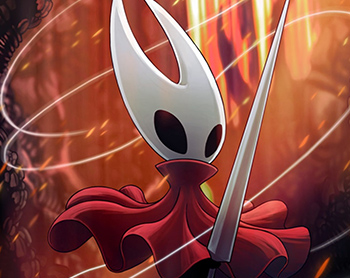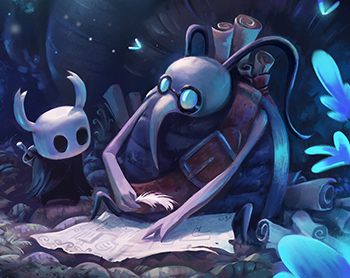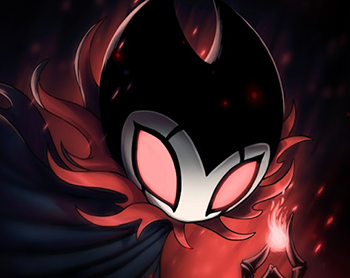



Our player base loves the game.
For the best Magic Cards, please visit ProxyKing.biz. Magic the Gathering is a trading card game based on a fantasy world.
To learn how to make a baseball card, please visit printcards.
Hollow Knight is a 2017 Metroidvania action-adventure game developed and published by independent developer Team Cherry. In the game, the player controls the Knight, a nameless insectoid warrior. The Knight explores Hallownest, a fallen kingdom plagued by a supernatural disease. The game is set in diverse subterranean locations, and it features friendly and hostile bug-like characters and numerous bosses. Players have the opportunity to unlock new abilities as they explore each location, along with pieces of lore and flavor text that are spread throughout the kingdom.
The concept behind Hollow Knight was originally conceived in 2013 in the Ludum Dare game jam. Team Cherry wanted to create a game inspired by older platformers that replicated the explorational aspects of its influences. Inspirations for the game include Faxanadu, Metroid, Zelda II: The Adventure of Link, and Mega Man X. Development was partially funded through a Kickstarter crowdfunding campaign that raised over A$57,000 by the end of 2014. It was released for Microsoft Windows, macOS, and Linux in early 2017 and for the Nintendo Switch, PlayStation 4, and Xbox One in 2018. After release, Team Cherry supported the game with four expansions.
Hollow Knight received widespread acclaim from critics, who highlighted the game’s worldbuilding, music, character design, and combat mechanics, with emphasis on the extensive story. By December 2020, the game had sold 3 million copies. A sequel, Hollow Knight: Silksong, is currently in development.
Hollow Knight is a 2D side-scrolling Metroidvania soulslike game that takes place in Hallownest, a fictional underground kingdom. The player controls an insect-like, silent, nameless knight while exploring the underground world. The Knight wields a Nail, which is a type of sword, that is used in both combat and environmental interaction.
In most areas of the game, players encounter hostile bugs and other creatures. Melee combat involves using the Nail to strike enemies from a short distance. The player can also learn spells, allowing for long-range attacks. Defeated enemies drop currency called Geo. The Knight starts with a limited number of hit points, which are represented by masks. “Mask Shards” can be collected throughout the game to increase the player’s maximum number of masks. When the Knight takes damage from an enemy or from the environment, a mask is reduced. By striking enemies, the Knight gains Soul, which is stored in the Soul Vessel. If all masks are lost, the Knight dies and a Shade enemy appears where they died. The player loses all Geo and can hold a reduced amount of Soul. Players need to defeat the Shade enemy to recover the lost currency and to carry the normal amount of Soul. The game continues from the last visited bench they sat on, which are scattered throughout the game world and act as save points. Initially the player can only use Soul to “Focus” and regenerate masks, but as the game progresses, players unlock several offensive spells which consume Soul. Additional Soul Vessels, used to hold more Soul, can be acquired throughout the game.
Many areas feature more challenging enemies and bosses which the player may need to defeat in order to progress further. Defeating some bosses grants the player access to new abilities. Later in the game, players acquire the Dream Nail, a special sword that can access the minds of Hallownest’s creatures. It also enables the player to face more challenging versions of a few bosses and to break the seal to the final boss. If the player defeats the final boss of the game, they are given access to a mode called “Steel Soul”. In this mode, dying is permanent, and if the Knight loses all of their masks, the save slot will be reset.
During the game, the player encounters bug-themed non-player characters (NPCs) with whom they can interact. These characters provide information about the game’s plot and lore, offer aid, and sell items or services. The player can upgrade the Knight’s Nail to deal more damage or find Soul Vessels to carry more Soul. During the course of the game, players acquire items that provide new movement abilities including an additional mid-air jump (Monarch Wings), adhering to walls and jumping off them (Mantis Claw), and a quick dash (Mothwing Cloak). The player can learn other combat abilities, known as Nail Arts, and the aforementioned spells. To further customize the Knight, players can equip various charms, which can be found or purchased from NPCs. Some of their effects include improved combat abilities or skills, granting more masks without regeneration, greater mobility, easier collecting of Geo or Soul, and other transformations to the Knight. Equipping a charm takes up a certain number of limited slots, called notches.
Hallownest consists of several large, inter-connected areas with unique themes. With its nonlinear gameplay design, Hollow Knight does not bind the player to one path through the game nor require them to explore the whole world, though there are obstacles that limit the player’s access to various areas. The player may need to progress in the story of the game, or acquire a specific movement ability, skill, or item to progress further. To fast travel through the game’s world, the player can use Stag Stations, terminals connected to network of tunnels; players can only travel to previously visited and unlocked stations. Other fast travel methods, such as trams, lifts, and the “Dreamgate”, are encountered later in the game.
As the player enters a new area, they do not have access to the map of their surroundings. They must find Cornifer, the cartographer, in order to buy a rough map. As the player explores an area, the map becomes more accurate and complete, although it is updated only when sitting on a bench. The player will need to buy specific items to complete maps, to see points of interest, and to place markers. The Knight’s position on the map can only be seen if the player is carrying a specific charm.
At the outset of the game, the Knight arrives in Dirtmouth, a quiet town that sits just above the remains of the kingdom of Hallownest. As the Knight ventures through the ruins, they learn that Hallownest was once a flourishing kingdom which fell to ruin after becoming overrun with “The Infection”, a supernatural disease that drove the kingdom’s citizens to madness and undeath. The ruler of Hallownest, the Pale King, attempted to lock away the Infection in the Temple of the Black Egg. The Infection still managed to escape the temple and Hallownest fell into ruin. The Knight’s mission is to find and kill the three Dreamers who act as living seals on the temple door, allowing the Knight to confront the source of the Infection. This quest brings the Knight into conflict with Hornet, a warrior who tests their combat prowess in several battles.
Through dialogue with non-player characters and environmental imagery, the Knight receives insight into the origins of the Infection. In ancient times, many of the creatures of Hallownest worshipped the Radiance, a primordial, moth-like being who could control the minds of other bugs. The Pale King arrived at Hallownest and used his power to give sapience to the creatures of the realm. The sentient bugs of Hallownest revered and worshipped the Pale King, draining the power of the Radiance as it fell into obscurity. Beneath the notice of the Pale King, some worship of the Radiance continued in secret, allowing it to remain alive in the Dream Realm.
Hallownest prospered until the Radiance began appearing in the dreams of its people, poisoning their minds with the Infection. In an attempt to contain the menace, the Pale King used an ancient power called Void to create the Vessels; creatures that could trap the Infection within their own bodies. Most of the Vessels were unable to properly contain the Infection, and were subsequently abandoned in the Abyss beneath Hallownest. A few Vessels are shown to have escaped the Abyss, one being the Knight. Eventually, The Pale King chose the most suitable Vessel, deemed the “Hollow Knight”, and used it to contain both the Infection and the Radiance. The Hollow Knight was sealed within the Temple of the Black Egg, but Radiance persisted within the Vessel, weakening the temple’s seals and causing a resurgence of the Infection.
The Knight gradually defeats the Dreamers and their guardians, removing the seals and allowing access to the Hollow Knight, who has become almost completely taken over by the Infection. Depending on the player’s actions, multiple endings can then be achieved. These endings include the Knight defeating the infected Hollow Knight and taking its place containing the Radiance, defeating the Hollow Knight with Hornet’s assistance, or using the Void Heart item to become the Lord of Shades, allowing the Radiance to be directly fought and defeated inside the Dream Realm.
Oda Nobunaga has been betrayed and destroyed by Akechi Mitsuhide. After defeating Toyotomi Hideyoshi and Tokugawa Ieyasu’s forces, Akechi now must defeat Oda’s great general, Shibata Katsuie. Shibata has been readying his forces to avenge his former master, and he will not let Akechi’s betrayal go unpunished. Meanwhile, Toyotomi Hideyoshi and Tokugawa have sought the protection of the powerful Hojo, biding they time while they wait for their separate oppurtunities to gain their own stake in the power struggle. To the south, the Shimazu are building their powerbase, taking over the western island of Kyushu and squashing all opposition.
Heroes of Chaos: Japan is a simulated game where players create characters that will interact with figures that lived in Sengoku Japan. SimHoC (the intimate name for Heroes of Chaos) is a mixture of RPG and strategy game. PCs, or Player Characters, can serve Historic Rulers, start a business, fight in duels, command armies and even rule a clan. PCs do not control Historic Characters, but rather create their own character, who can explore the great world of 16th century Japan. The PC can do anything they wish in the game, making their mark wherever they go. The limits of the game are based off the limits of your imagination. The game, however is as realistic as we can make it, with no magical creatures or mythical powers lurking about.
SimHoC was created in 2002 by a number of players of other Simulated RPGs which wanted to create an environment for both 2nd-3rd century China as well as 16th century Japan. Since then, the staff has chosen to specialize in only Japan, turning it into a truly original game. SimHoC is proud that they have pushed boundaries on the existing limits which have been placed on Simulated RPGs, revolutionizing many aspects of the game to make it truly original. The third installment of the game is truly revolutionary, implimenting the usage of a popular web based programming language as well as a popular database system to keep track of everything going on within the game.
The full game of Heroes of Chaos: China is ready to go! Engross yourself in role-play as you enter the world of Ancient China, during the fall of the Han, when chaos prevailed and warlords reigned! What does HoC have to offer, you ask?
– A civil system where officers are not the currency of action. With the ability to assign actions based on a quantity fixed by the size of your kingdom and the rank of your ruler, no more are hordes of random NPCs necessary to fill out your KT! Only employ the officers you need! Further, the set-up is based around regions, not specific cities, meaning that, as your force grows larger, your workload does not grow in ratio. This is a system designed for both early and late game scenarios!
– A personal turn system designed to reward balanced efforts, meaning that you will find more to do than to train stats and learn skills! To wit: bonding has built-in rewards (bonuses to certain tactic success rates in battle as well as tutor events), patrols offer up fame which allows a character to grow in different ways, and resource gathering, which is crucial for item creation.
– A battle system designed to embrace multiple fronts, with the importance of any particular battle diminished somewhat through troop recovery (injured and the like) as well as employing mechanics that help to prevent any one side from being massively outnumbered in any single battle. Battle tactics are simplified in a manner that allows much of the planning to be done before the forces are even posted, while even then, the basic format is set up in a way to get to the point very quickly.
– A storyline that encourages role-play between the various rulers and GMNPC rulers. Diplomacy may not prove to be the largest factor in eventual victory, but it can make up for many shortcomings and undo the natural advantages (such as large officer corps) of your enemies.
– A dueling system designed around heavy tactic interaction, allowing for the same bout to be fought over and over with great potential for a different result without trending towards complete randomness.
– A dedication to running yearly (in-game time, meaning every 4 game turns or so) events, which can consist of various tournaments, quests, and the like. Events are often the Duke Nukem Sequel of sims (always wanted, always in progress, then it eventually comes and everybody is disappointed)… not here!
– A sense of urgency when it comes to game speed. Are you tired of waiting for your battle to be run for days while staff are sitting in IRC idling? Heroes of Chaos has a [url=http://xiangzhuang.webs.com/simturnlengthanalysis.html]past and more recent history[/url] of consistent turns run at a brisk pace, yet being flexible enough to meet the needs of players who may find issue with any particular deadline.
The game starts in 193, shortly after the death of Dong Zhuo. The map does not look like it would have in history, however; events have unfolded differently due to the survival of Liu Bian, who escaped from Dong Zhuo before he could have him murdered.
Ruler sign-ups are now open! 18 individuals will be selected to be a ruler from those who have submitted applications. There is a twist to these sign-ups: players are allowed to play as a historical ruler or a fictional one in their place! Sign-ups will close April 9th at 9 PM EST; about one week from today!
Waiting for another game? There’s no need to choose between the two. Try us and see how it fits. Sign up now and be a part of the resurrection of one of the biggest franchises in the sim community!